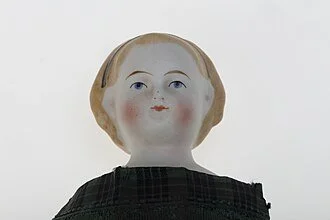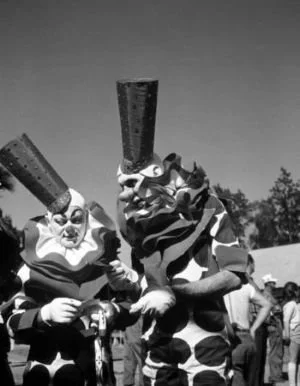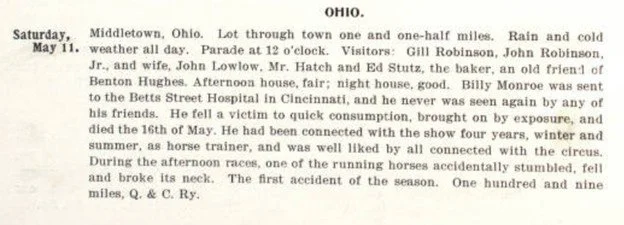The Eerie
Creepy. Eerie. Unsettling. Why do some things that we would normally love give us shivers up our spines? It is thanks, in part, to horror movies, but did these fears predate the genre? Predate film? Possibly. There are certainly reasons beyond horror movies, but we’re not here for a psychological investigation. We’re here to explore what the Internet has to offer in the way of source material.
So, without further ado…
Dolls
Dolls are a childhood delight, a horror movie trope, and a collector’s dream. These toys date back thousands of years in one form or another. According to Wikipedia, there are Japanese dolls extant dating back to 8000 BCE and Egyptian dolls from the 21st century BCE. These early dolls were little more than a vaguely human shape, possibly with straw for hair. Later dolls were made of cloth, porcelain, bisque, or plastic.
Source: Wikimedia Commons, ℅ Missouri Historical Society
There are a couple of museums with good online collections of dolls.
The Dolls Around the World Virtual Museum provides galleries of dolls representing different continents, including Oceania. Each doll features a picture of the doll along with information about the maker, markings, and other details.
The Henry Ford Museum also has a large collection of dolls and doll-related materials. For each of the over 500 objects in the collection, the museum provides information about the creator, place and date of creation, materials used, technique, color, and dimensions.
Source: Wikimedia Commons. Marionette play, played by Christian Fuchs. Puppet: Replica (2015) of the puppet “The Hunchback” made at the Bauhaus. Original design by Kurt Schmidt, executed by Toni Hergt, 1923.
I love marionettes. As a child, I was super envious of the Von Trapp family’s marionette theater. Yodel-ay-heeeeeeee! As an adult, I had the opportunity to see Don Giovanni performed in a Czech marionette theater. It was lovely.
Despite that, I can totally see why people think they are creepy. They have the same dead eyes as a doll, but they can move, too. *shudder*
Ultimately, though, puppets and marionettes exist to delight audiences. They are an art form combining crafting, painting, costuming, and theater. Such artistry is worthy of a museum.
One such museum, the Ballard Institute and Museum at University of Connecticut, has some wonderful online exhibits of marionettes and puppets. Each one features a different subset of puppets, carefully curated and explained. (Note: not all exhibits mentioned on the linked site are available virtually.)
If you are interested in learning about how automata were received in the early 19th century, HathiTrust offers Observations on the Automaton Chess Player now exhibited in London at 4, Spring Gardens, published in 1819. The author disbelieves that the movement could be entirely mechanical and wonders how the human manipulation is achieved. Or another book, published 2 years later, that concludes that there is someone inside the machine behind a false back, controlling the movement from within.
In the way of marionettes, I also offer you this 1898 Lumiere film of a dancing skeleton that is clearly manipulated by strings.
The Circus and the Carnival
Finally, we come to my favorite of the uncannily eerie - the circus. Carnival of Souls is one of my favorite horror movies. (see also: Something Wicked This Way Comes)
Source: Wikimedia Commons. Cover of 4-page pressbook for 1962 film Carnival of Souls. Illustration by F. Germain. Published by Herts-Lion International Corp.
There are dozens of circus museums and library collections around the world, but not all of them have digital collections. Of those that do, two are especially interesting.
First, the Ringling Brothers Museum. The museum’s digital collections feature photos, films, programs, trading cards, advertisements, newspapers, and more. The films in the Buster Bailey Collection are especially exciting.
Source: Florida State Archives. Ringling Circus clowns Albert "Flo" White, left, and Gene Lewis in Sarasota, Florida
Second, the Milner Library at University of Illinois has an impressive collection of circus memorabilia. Particularly fascinating from a research perspective are the Route Books. Look at the trove of information found in this one small snippet from the Route Book of the Great Wallace Show Season 1895. In one paragraph, we get the weather, the visitors, the success of the show, a death, and the loss of an animal.
Transcription: Ohio. Saturday, May 11. Middletown, Ohio. Lot through town one and one-half miles. Rain and cold weather all day. Parade at 12 o’clock. Visitors: Gill Robinson, John Robinson, Jr., and wife, John Lowlow, Mr. Hatch and Ed Stutz, the baker, an old friend of Benton Hughes. Afternoon house, fair; night house, good. Billy Monroe was sent to the Betts Street Hospital in Cincinnati, and he never was seen again by any of his friends. He fell a victim to quick consumption, brought on by exposure, and died the 16th of May. He had been connected with the show four years, winter and summer, as horse trainer, and was well liked by all connected with the circus. During the afternoon races, one of the running horses accidentally stumbled, fell and broke its neck. The first accident of the season. One hundred and nine miles, Q. & C. Ry.
Conclusion
Maybe exploring the reality of these eerie subjects will take away some of the uncanny feeling we have around them. Even if it doesn’t, there is still some fascinating information to be found. What have I missed? What do you find eerie? Join me next week for further spooky adventures!





